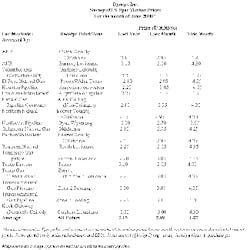It's just about unthinkable for a long-time natural gas market watcher: Spot gas prices are now well above $4/MMbtu, and the market is in what had once been the doldrums season-the weeks before summer.
Clearly, physical fundamentals are driving the current market, and, as is usually the case with tight markets, the problems are on the supply end.
The question now becomes: Just how high can gas prices go this year? With NYMEX July gas futures prices already nudging $4.50/MMbtu this week and spot prices averaging $4.27/MMbtu for the month of June, is $5/MMbtu out of the realm of possibility even before the summer is out?
That's readily conceivable, especially as the onset of hurricane season in the Gulf of Mexico coincides with the approach of higher temperatures. Even hurricanes that don't do any damage cause supply disruptions as platform operators closely monitor storm movements and shut in and evacuate platforms at the approach of a major storm, thereby disrupting supplies. And the continually increasing percentage of cooling load fired by natural gas has contributed to a still more pronounced flattening of the seasonal demand curve for natural gas. So there is the near-term prospect of further, temporary price spikes as a result of price pressures at both the supply and demand ends of the market.
The past week has seen a pretty wild swing in the NYMEX gas futures price, jumping to more than $4.40, then slumping to less than $4 before rebounding to about $4.15. The decline was apparently spurred by a temporary slackening in demand as the weather remained mild in the US East and some businesses shut down for the Memorial Day holiday, which subsequently allowed an increase in the rate of storage injection.
Still, as PaineWebber notes, "_Near month backwardation remains intact. For example, July NYMEX is currently selling 2¢ higher than August (and only 12¢ lower than December and January.
"Clearly, this will not incentivize those with discretion to inject now to lock in profits."
The futures price strip for the next 6 months is hovering right at about $4, while the 12-month strip is trading at $3.76/MMbtu, which is 44
Perhaps even more telling is that spot prices for natural gas, as measured by Dynegy Inc.'s survey, average at a level that is roughly double what it was a year ago and up more than $1 from just a month ago. A heat wave in the US Southwest was a contributor to the spot price bull run, but the supply concerns suggest that a composite price of more than $4 in July should not come as too much of a surprise.
Storage concerns
The injection of 78 bcf of gas into storage last week was an improvement over the prior week's rate and compares favorably with the rate of injection for the second week of June a year ago (which would compare with this week's expected rate).
But the year-to-year storage deficit has continued to grow, to 442 bcf last week from 429 bcf and 414 bcf in the prior two weeks. Given the recent track record on storage injection, however, the deficit is likely to just keep getting bigger.
Right now, storage levels are at about 1.352 tcf, vs. almost 1.8 tcf at the same time a year ago, an average 1.6 tcf the preceding 3 years, and an average 1.5 tcf the preceding 5 years. In order to reach the magic number of about 3 tcf held in storage at the start of the heating season Nov. 1, injection rates will have to average 78 bcf/week. That compares with refill rates of 57 bcf for the same period last year and an average 69 bcf for the same period during the previous 5 years. In other words, don't count on it; count instead on storage falling short of needs by about 500 bcf at the start of the heating season.
With such market fundamentals, shouldn't producers be drilling like crazy and thus putting a bit more slack into the market? Well, while rig counts in the US and Canada are up strongly-especially for natural gas-directed rigs, the lag time that typically follows a price run-up this time is being extended by producers' struggle with cash availability. Coming out of the oil price slump, many producers are directing more cash flow to paying down debt stacked up during the downturn. Perhaps even more ominously, investors remain a bit skittish of the oil and gas sector-partly because of the commodity price volatility but also because they are looking more at long-term performance that weathers such price rollercoasters.
As the luster begins to fade from the dot-com investment bandwagon, investors are likely to begin returning to oil and gas stocks in the near-to-midterm, just as producers begin scurrying around chanting the new mantra of "capital efficiency" rather than production and reserves growth for its own sake and betting on the come with commodity prices.
The trouble is, those trends are evolving too slowly to put much gas into storage reservoirs now or even in the fall.
Unless the weather forecasters fall flat on their face once again this winter, there could be some pretty startling price movements around the turn of the year-and $5/MMbtu might sound like a comfortable floor.
Table 1
null
OGJ Hotline Market Pulse
Latest Prices as of June 9, 2000
null
null
Nymex unleaded
null
Nymex heating oil
null
IPE gas oil
null
Nymex natural gas
null








